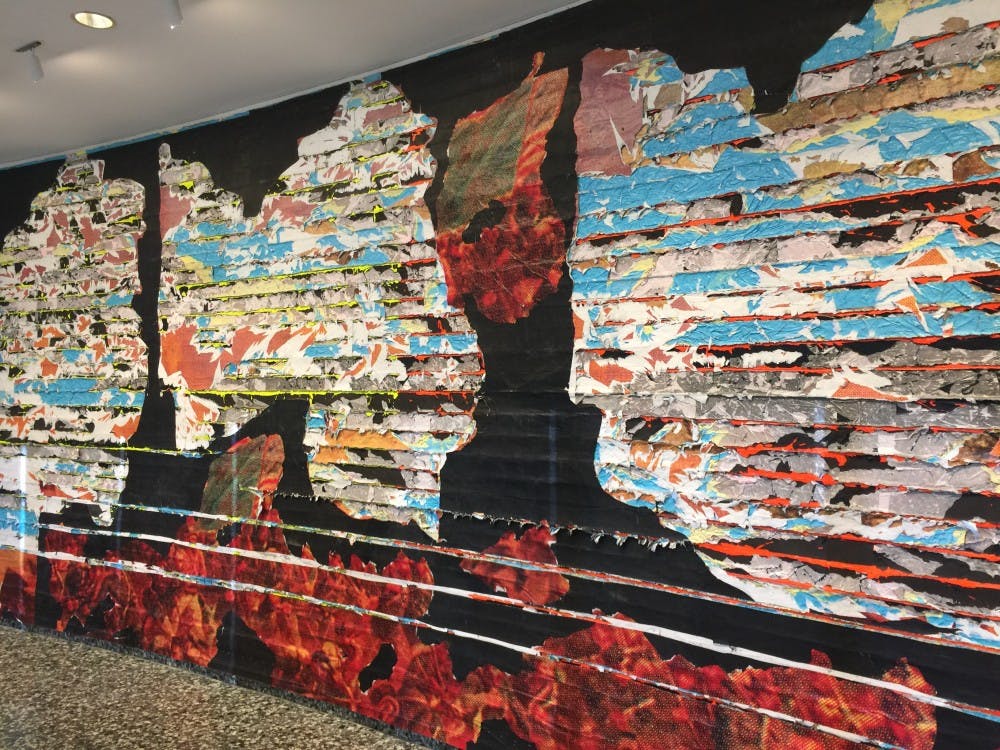On Wednesday March 7, the Baltimore Museum of Art (BMA) hosted a discussion between Stephen Towns and Mark Bradford. Audience members from Hopkins, the Maryland Institute College of Art (MICA) and the Baltimore community gathered in the museum’s newly renovated auditorium for the opportunity to hear from these two artists. The turnout for the event was clearly more than the museum had anticipated: The line for entry snaked around the museum and some members of the audience were forced to stand in the back.
One noteworthy audience member was Amy Sherald, the Baltimore-based artist who painted Michelle Obama’s official portrait. Before the event started, Sherald was asked to stand and received a booming round of applause from the crowd.
The event surrounded the opening of Towns’ new quilt exhibit titled Rumination and a Reckoning, which will be on display at the BMA until Sept. 2 of this year. Though his work has been exhibited at other venues including the Arlington Arts Center, Galerie Myrtis, Gallery CA and Goucher College’s Rosenberg Gallery, this is the first time it will be displayed in a museum.
While BMA Director Christopher Bedford remained onstage for the duration of the talk, the discussion was centered around Towns and Bradford: their art, their upbringings and their experiences navigating the world as black gay men.
The artists first spoke about Towns’ choice to use quilting as a medium. Towns explained that he learned to sew from a young age and eventually perfected the technique through watching YouTube videos.
Later Towns elaborated that the act of quilting was associated with labor, which ties into his motifs of slavery and labor practices. He said that, at times, he would work so much that his blood would seep into the quilts.
Another major topic of discussion was the role that religion played in Towns’ life. The artist grew up as a Jehovah’s Witness, which he described as an “isolated” religion. While he is no longer a part of the church, he explained that he is in a place of “spiritual awareness.”
At the same time, he also stated his belief that he will never be able to escape elements of his religious upbringing. A number of his works, in both oil paintings and quilts, involve Biblical allusions and quotes.
Towns, known for his portraits of black men and women with halos, explained that this element of his work has both religious and cultural significance. While he noted that it is part of his break from the Jehovah’s Witness notion of God being superior to all humans, the halos are also a form of protest against racism.
“It’s hard to tell black people that they’re ugly when they have a golden halo behind them,” he said.
The artist also commented on his quest to understand himself and his identity through an exploration of American history, specifically slavery. He described his interest in novels and narratives related to slavery, including Uncle Tom’s Cabin and 12 Years a Slave. This theme is apparent in many of his works, including those that are presented through quilting in the current exhibit.
On the subject of racism in the United States, Towns also spoke on the role of black women in building the foundation of the country without respect or recognition. This sentiment is represented in one of Towns’ quilts, titled Birth of a Nation, which depicts a black woman nursing a white baby on an American flag background.
The Q&A portion of the program included a statement by a member of the crowd who was also a black Baltimore-based artist. She commented on the significance of including Towns’ work in the museum.
“Even though you aren’t the first black artist to be featured at the BMA, it feels like the first time that I’m at the BMA,” she said.
Another comment was made by a faculty member at Goucher University who asked about a past controversy at the school over the displaying of Towns’ portraits of black men and women who had been killed in a slave uprising. Towns explained that he had agreed to have his work removed out of respect for a black staff member who was uncomfortable with the depictions.
The final question involved the inclusion of black artists in predominantly white spaces like the BMA. Bradford responded to this question by declaring that institutions like the museum have to progress and that there is a long history of artists from minority backgrounds forcing this progress to continue.
“You demand to be part of the conversation, then history will shape-shift around you,” he said.





